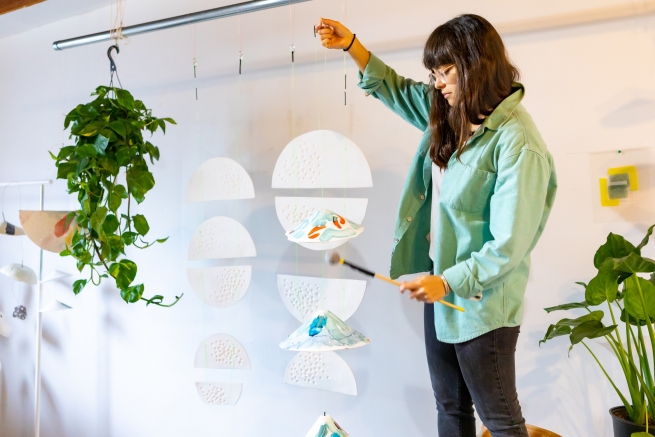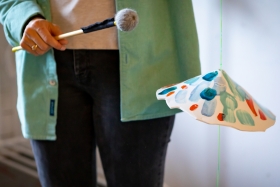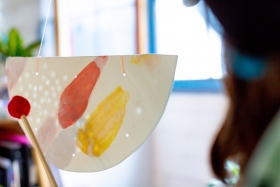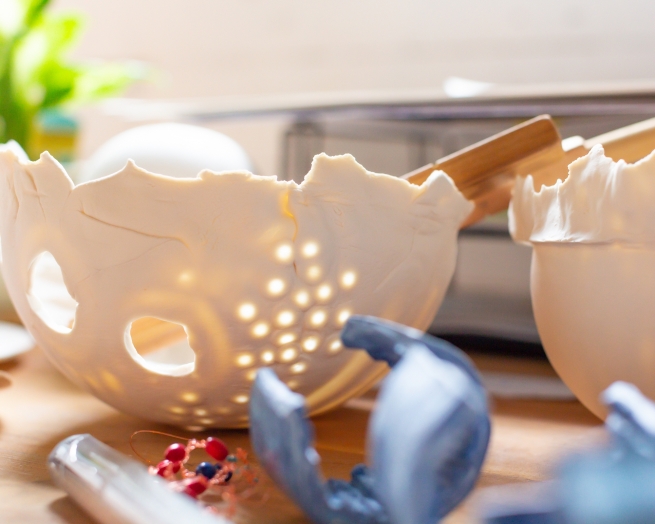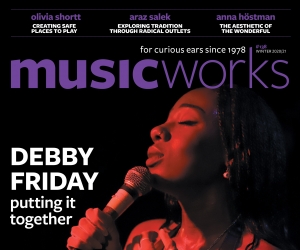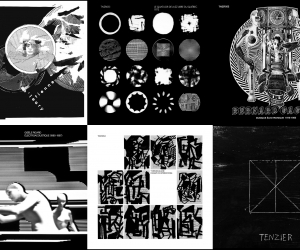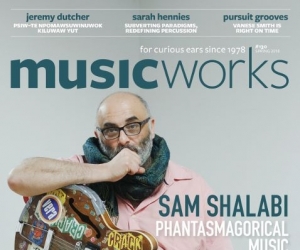Nesbitt weaves together ideas from acoustics, composition, design, and sound art, using self-made instruments and objects to construct unexpected worlds of sound. Her work hinges on soundmaking and design in various forms: as a composer, creating music for acoustic instruments, objects, or electronics; as an improviser and bassist; and as a performer-songwriter for her art-pop formation Graftician. Trained as both a classical double bassist and an architect, she frequently works with clay, wood, and stone to build new instruments or to craft appendages for existing ones that unearth hidden layers of resonance. Throughout her music, Nesbitt maintains a uniquely subtle sense of exploration and play that draws the listener in, towards instruments with contours and timbres that are just unfamiliar enough to feel new.
Nesbitt was born in Edmonton, Alberta, where she learned double bass and pursued a bachelor’s degree in orchestral double-bass performance at the University of Alberta. In 2011, she decided to leave classical performance to follow her growing interest in acoustics and design and moved to Vancouver to begin graduate studies in architecture at the University of British Columbia.
“I learned a lot of really good skills [at UBC],” Nesbitt tells me from Vancouver during a video call in October 2021. “I re-engaged with drawing and learned a lot about materials and design. But I could never really get into buildings as much as I wanted to. I kept going back to instrument design. And eventually I focused my degree that way, to be about acoustics, materials, and listening.”
“When I was trying to just make normal, functional buildings, it was a bit incongruent—it just didn’t work,” she adds. “And once I was able to join those interests, everything felt effortless.”
In many of Nesbitt’s works, it’s hard to tell where the element of design stops and the act of composing begins. She often places ceramic bowls and bars that she’s sculpted on top of a drum membrane or on the strings of a piano, where they rock back and forth, dampening and distorting the sounds of the instruments. Other pieces call for hand-crafted ceramic flutes or trumpet “mute-rattle hybrids,” which contain small materials that jingle when the player moves or blows. Others use sound to subvert everyday spaces, such as floor tiles and stairs made of stone or concrete that are tuned to reverberate at certain intervals when stepped on or struck.
Nesbitt found herself drawn to the possibilities of clay, and to the openness of the craft world toward using homemade objects as instruments, when she took a ceramics course taught by Dutch ceramicist Addy Bloem in Amsterdam in 2016. Since then, ceramics have figured prominently in her music. “I learned ceramics in order to make instruments,” she explains. “I wanted different shapes, I wanted curvilinear pieces, and I wanted things that I couldn’t really get out of other materials. I was craving something fluid and flexible.”
In Wild Bells No.5, an installation Nesbitt developed in 2020 during a four-month-long artist residency at the European Ceramic Work Centre (EKWC) in Oisterwijk, Netherlands, dozens of flat ceramic pieces—some smooth, some perforated, others rippling with lava-like textures—are strung from the ceiling, each bent at a different angle. Light filters through the dangling objects, lending them a flexible yet fragile quality—as if, while folding in on themselves, they froze just before snapping. In a video of the installation, Nesbitt breaks the illusion of fragility when she strikes the ceramics with a mallet. They ring with deep, meditative clarity, creating eerie, irregular scales as she plays them in sequence.
This past summer, during a second residency at the EKWC, Nesbitt developed the ceramics for Death and the Rest, which was composed for the Dutch contemporary music ensemble Modelo62. The ensemble premiered the piece at the 2021 Gaudeamus Muziekweek festival, held in September, and performed it again at November Music, an annual contemporary music festival held in Den Bosch.
Death and the Rest is written for prepared piano, double bass, cello, classical guitar, violin, trumpet, clarinet, flute, and extended percussion, and includes ceramic percussion instruments and piano preparations designed by Nesbitt. Notated as a graphic score and unfolding over four movements, the work derives from Nesbitt’s own thoughts on grief and mourning following the passing of her father. At times, the music sounds deceptively simple— resonant chords or tones played for the length of a single bow or breath. Elsewhere—in the third movement, for example—it’s more textural and percussive. The percussionist plays a set of handmade ceramic bells, each shaped into the form of a floating half-moon. The sound is hollow and wobbly as they swing gently through the air, casting shadows on the ground.
Some of Nesbitt’s ceramic objects, such as rough-edged bowl-like shapes that serve as piano preparations in several of her compositions, are part of her Symbiotic Instruments series, a “sonic investigation” into classical instruments, as she calls it, which she began in 2016. “The idea was to make resonant objects that really changed the character of a standard instrument, without needing a whole new instrument,” she explains. “Trying to take into account some of the logistics of travel, sustainability, and accessibility around instrument design, but also wanting a different sound palette.”
In repetition, the ceramics become a kind of infinitely reusable and reproducible artist’s multiple. “In a way, it’s an issue of access,” she says. “The canon of instruments that we have has become so standard. In a way, that’s problematic, because it limits what our sound palettes are. But we can use that [standardized canon] as something to be manipulated.”
“I don’t want my work to become something that’s super exclusive, that belongs to a collector, or that regular people don’t have access to,” she continues. “[I don’t want to] make giant, precious things, where there only gets to be one copy. And by making something smaller and more repetitive, it’s something that can be shared—and it’s also something that people can make on their own.”
The idea of sharing musical resources also informs Nesbitt’s work as an organizer. In the fall of 2020, she began working with Vancouver-based multidisciplinary artist, drummer, musician, and web developer Anju Singh in preparation for an outdoor performance of Nesbitt’s work Wild Bells No. 4 for Vancouver New Music. In the process, they started discussing new ways of building equitable networks and opportunities in their communities, deciding to work together to create more accurate representation of experimental artists.
They're now collaborating on the creation of a digital archive, slated for publication in early 2022, of artists with experimental practices—starting with other BIPOC artists working with music or sound. “[Singh and I] had this conversation about how weird it was that we’d never met before,” says Nesbitt. “We have similar interests and practices but were never able to find one another. And that’s why we had the idea to make an archive that is separate from existing, corporate social media.”
Nesbitt and Singh's work together has also led to the creation of Currently Arts Society—a Vancouver-based organization with a mandate to curate, promote, and commission experimental art and music across genres and disciplines, which will begin activities in 2022.
For Nesbitt, a crucial reason for establishing Currently Arts Society was to build a community organization where artists who are frequently underrepresented in arts institutions are put first, rather than treated as afterthoughts. “There’s been a lot more conversation about diversity and inclusion in the arts in the past couple years, but what we were finding was that it was a lot of all-white organizations trying to bring in artists of colour to make their existing organizations seem inclusive,” she says. “For me, that resulted in a lot of tokenism, and feeling sometimes like ‘oh, I just got this gig that totally doesn’t fit me, because you wanted to have a Brown person.’ We wanted to start our own BIPOC-run organization, to deal with equity and inclusion on our own terms—and also so that if these ideas potentially go out of style for some curators and promoters, we have our own ecosystem to interact with.”
In the description of Symbiotic Instruments on her website, Nesbitt writes that she seeks to divorce herself from “macho, misogynistic attitudes which still dominate avant-garde, experimental music and new instrument design” by juxtaposing “mass-produced, standardized, and highly-tuned instruments with the intuitive work of the hand.” I imagine that the experience of playing one of Nesbitt’s instruments would be imbued with that same intuitive, tactile sense of discovery, serving as a reminder of how music can be defined by the shape and substance of the object it comes from. Nesbitt explains how, at least within Western tradition, classical instruments are so ubiquitous that they are often a more accessible and easily adaptable entry point into music-making than any instrument she could build from scratch. At the same time, that classical-era instrumental hegemony makes each of Nesbitt’s ceramic objects a tiny intervention into how we think about sound in the context of history. “I don’t want to valorize the instruments of an era when I would’ve been property and my ancestors would have been indentured labourers,” Nesbitt tells me. “I don’t really want to celebrate the aesthetics of the good old days, because they wouldn’t have been good for me.”
“But by making something new, I feel like I can explore sounds without the heavy baggage on top of it,” she adds. “I feel like I have a voice in my music-making—like I’m free.”
PHOTOS: Andi McLeish
FYI: As part of her ongoing Symbiotic Instruments series, Roxanne Nesbitt is working on an album featuring percussionist and composer Ben Brown, pianist Marielle Groven, and Nesbitt as composer and bassist, due to be released in 2022.
ON THE CD: Death and the Rest
